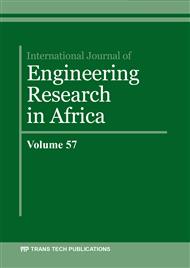[1]
Agence de Promotion de l'Industrie et de l'Innovation. Les industries des matériaux de construction, de la céramique et du verre en Tunisie. APII, Tunisia. (2014).
DOI: 10.3406/estat.1964.9240
Google Scholar
[2]
A.A. Akhlaruzzman, and A. Hasnat, Properties of concrete using crushed brick as aggregate, ACI Concrete International: Design and Construction, 5(2) (1983) 58-63.
Google Scholar
[3]
Ali A. Aliabdo, Abd-Elmoaty, M. Abd-Elmoaty, Hassan, H. Hani, Utilization of crushed clay brick in concrete industry, Alexandria. Engineering. Journal. 53 (2014) 151-168.
DOI: 10.1016/j.aej.2013.12.003
Google Scholar
[4]
P.B. Cachim, Mechanical properties of brick aggregate concrete, Construction and Building Materials, 23 (2009) 1292–1297.
DOI: 10.1016/j.conbuildmat.2008.07.023
Google Scholar
[5]
X.Cai1, J.Yuan, W.Yang, and X.Zhang, Behavior of concrete with recycled clay brick as coarse aggregate, ICTE, (2019), https://ascelibrary.org/doi/pdf/10.1061/9780784482742.092.
DOI: 10.1061/9780784482742.092
Google Scholar
[6]
F. Debieb, and S. Kenai, The use of coarse and fine crushed bricks aggregate in concrete, Construction and Building Materials, 22 (2008) 886–893.
DOI: 10.1016/j.conbuildmat.2006.12.013
Google Scholar
[7]
T.C. Hansen, Recycling of Demolished Concrete and Masonry. Report of Technical Committee 37-DRC Demolition and Reuse of Concrete, RILEM, E & FN Spon, London (1992).
Google Scholar
[8]
Y. Jian, D. Qiang, and B. Yiwang, Concrete with recycled concrete aggregate and crushed clay bricks. Construction and Building Materials, 25 (2011) 1935–(1945).
DOI: 10.1016/j.conbuildmat.2010.11.063
Google Scholar
[9]
S. Kenai, F. Debeib, and L. Azzouz, Performances of concrete made using brick masonry as coarse and fine recycled aggregates. Discovery, recycling, re-integration, R'02-6th world. Congress on integrated resources management, Geneva (2002).
Google Scholar
[10]
S. Kenai, and F. Debieb, Characterization of the durability of recycled concretes using coarse and fine crushed bricks and concrete aggregates, Materials and Structures, 44 (2011) 815–824.
Google Scholar
[11]
FM. Khalaf, and AS. Devenny, Recycling of demolished masonry rubble as coarse aggregate in concrete, ASCE Journal of Materials in Civil Engineering, 16(4) (2004) 331-40.
DOI: 10.1061/(asce)0899-1561(2004)16:4(331)
Google Scholar
[12]
JM. Khatib, Properties of concrete incorporating fine recycled aggregate, Cement and Concrete Research, 35 (2005) 763-9.
DOI: 10.1016/j.cemconres.2004.06.017
Google Scholar
[13]
AR. Khloo, Properties of concrete using crushed clicker brick as coarse aggregates, ACI Mater. J, 91(2) (1994) 401-407.
Google Scholar
[14]
T. Kibriya, Speare, and P.R.S., The use of crushed brick coarse aggregate in concrete. Proceedings of the International Conference, Dundee, (1996) 495–503.
Google Scholar
[15]
MB. Leite, and VM. Santana, Evaluation of an experimental mix proportion study and production of concrete using fine recycled aggregate, Journal of Building Engineering, 21 (2019) 243-253.
DOI: 10.1016/j.jobe.2018.10.016
Google Scholar
[16]
F. L. Gayarre, J. S. González, C. L. Pérez, M. López, R. Siddique, Performance of concrete based on recycled brick aggregate. Advances in Construction and Demolition Waste Recycling, Wood head Publishing, (2020) 321-337.
DOI: 10.1016/b978-0-12-819055-5.00016-4
Google Scholar
[17]
C-S. Poon, and D. Chan, The use of recycled aggregate in concrete in Hong Kong Resources, Conservation and Recycling, Elsevier, 50(3) (2007) 293–305.
DOI: 10.1016/j.resconrec.2006.06.005
Google Scholar
[18]
M. T. Uddin, A. H. Mahmood, M. R. I. Kamal, S. M. Yashin, and Z. U. A. Zihan, Effects of maximum size of brick aggregate on properties of concrete, Construction and Building Materials, 134 (2017) 713–726.
DOI: 10.1016/j.conbuildmat.2016.12.164
Google Scholar
[19]
Ch. Zheng , C. Lou, G. Du, X. Li, Z. Liu and L. Li, Mechanical properties of recycled concrete with demolished waste concrete aggregate and clay brick aggregate, Results in Physics, 9 (2018) 1317–1322.
DOI: 10.1016/j.rinp.2018.04.061
Google Scholar
[20]
L. Zhu and Z. Zhu, Reuse of clay brick waste in mortar and concrete, advances in materials science and engineering, Hindawi, 2020 (2020), https://doi.org/10.1155/2020/6326178.
DOI: 10.1155/2020/6326178
Google Scholar
[21]
J. S. González, F. L. Gayarre, C. L. Pérez, P. S. Ros , M. López, Influence of recycled brick aggregates on properties of structural concrete for manufacturing precast prestressed beams, Construction and Building Materials, Vol 149 (2017) 507–514.
DOI: 10.1016/j.conbuildmat.2017.05.147
Google Scholar
[22]
INORPI, Ciment: Composition, Spécification et Critères de Conformité. NT47-01. Tunisia (1996).
Google Scholar
[23]
T. Sedran, and de F. Larrard, BétonlabPro2-Logiciel d'aide à la formulation des bétons version 2.14. Presses de l'École nationale des Ponts et Chaussées, Paris, France (2000).
Google Scholar
[24]
F. De Larrard, and Le Roy, Un modèle géométrique d'homogénéisation pour les composites bi-phasiques à inclusion granulaire de large étendue. Comptes rendus de l'Académie des Sciences, t.314, série II, (1992) 1253-1257.
Google Scholar
[25]
Z. Hashin, The elastic modulus of heterogeneous materials, J. of App. Mech, 29 (1962) 143-150.
Google Scholar


